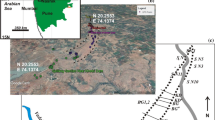Abstract
Magnetic properties of two apparently unrelated lava suites (one tholeiitic and the other alkalic) coexisting in the central parts of the Peninsula of Baja California, Mexico, were measured in this study. Macroscopic indicators and measurements of anisotropy of magnetic susceptibility (AMS) were combined to infer the flow direction on those lavas. These measurements were used to investigate the likelihood of the existence of an abnormally long tholeiitic lava flow in this part of the Peninsula. The obtained results indicate that the tholeiitic flows in the region constitute regular length flows, and are likely to have been issued through vents located within the area of study. Additionally, comparison of the magnetic signature of tholeiitic and alkalic lavas reveals a systematic difference in some of the magnetic parameters (bulk susceptibility and Curie temperatures). In particular, it is proposed that the narrow range of Curie temperatures characteristic of each lava type can be used as a reliable proxy for the identification of each lava type in the region. All of these findings show that the alkalic and tholeiitic lavas of the region are more closely related to each other than previously suspected.







Similar content being viewed by others
References
Brooks CK, Larsen ML, Nielsen TFD (1991) Importance of iron-rich tholeiitic magmas at divergent plate margins: a reappraisal. Geology 19:269–272
Cañón-Tapia E, Coe R (2002) Rock magnetic evidence of inflation of a flood basalt lava flow. Bull Volcanol 64:289–302
Cañón-Tapia E, Rojas-Beltrán MA (2001) Basaltic volcanic fields across the central part of the Peninsula of Baja California: tectonic implications. EOS 82:F1262
Cañón-Tapia E, Walker GPL, Herrero-Bervera E (1995) Magnetic fabric and flow direction in basaltic pahoehoe lava of Xitle volcano, Mexico. J Volcanol Geotherm Res 70:21–36
Cañón-Tapia E, Walker GPL, Herrero-Bervera E (1996) The internal structure of lava flows — insights from AMS measurements I: near vent aa. J Volcanol Geotherm Res 70:21–36
Cañón-Tapia E, Walker GPL, Herrero-Bervera E (1997) The internal structure of lava flows — insights from AMS measurements II: Hawaiian pahoehoe, toothpaste lava and ‘a’a. J Volcanol Geotherm Res 76:19–46
Carmichael ISE (1991) The redox states of basic and silicic magmas: a reflection of their source regions? Contrib Mineral Petrol 106:129–141
Carmichael ISE, Nicholls J (1967) Iron–titanium oxides and oxygen fugacities in volcanic rocks. J Geophys Res 72:4665–4687
Cas RAF, Wright JV (1987) Volcanic successions modern and ancient. Unwin Hyman, London
Constable C, Tauxe L (1990) The bootstrap for magnetic susceptibility tensors. J Geophys Res 95:8383–8395
Delgado-Argote LA, Danobeitia JJ, Fabriol H, Córdoba D (1997) The tortugas ridge: source region of the Tholeiitic basalt of Esperanza, central Baja California Peninsula. IAVCEI, General Assembly, Puerto Vallarta
Gastil G, Krummenacher D, Minch J (1979) The record of Cenozoic volcanism around the Gulf of California. Bull Geol Soc Am 90:839–857
Grommé CS, Wright TL, Peck DL (1969) Magnetic properties and oxidation of iron–titanium oxide minerals in Alae and Makaopuhi lava lakes, Hawaii. J Geophys Res 74:5277–5294
Hagstrum JT, Sawlan MG, Hausback BP, Smith JG, Grommé CS (1987) Miocene paleomagnetism and tectonic setting of the Baja California Peninsula, Mexico. J Geophys Res 92:2627–2639
Herrero-Bervera E, Walker GPL, Cañón-Tapia E, Garcia MO (2001) Magnetic fabric and inferred flow direction of dikes, conesheets and sill swarms, Isle of Skye, Scotland. J Volcanol Geotherm Res 106:195–210
Hext R (1963) The estimation of second-order tensors, with related tests and designs. Biometrika 50:353–373
Hrouda F (1994) A technique for the measurement of thermal changes of magnetic susceptibility of weakly magnetic rocks by the CS-2 apparatus and KLY-2 Kappabridge. Geophys J Int 118:604–612
Jelinek V (1978) Statistical processing of anisotropy of magnetic susceptibility measured on groups of specimens. Studia Geoph Geod 22:50–62
Knight MD, Walker GPL (1988) Magma flow directions in dikes of the Koolau Complex, Oahu, determined from magnetic fabric studies. J Geophys Res 93:4301–4319
McLean H, Hausback BP, Knapp JH (1987) The geology of west-central Baja California Sur, Mexico. US Geol Surv Bull 1579
Moskowitz BM (1981) Methods for estimating Curie temperatures of titano-magnetites from experimental Js–T data. Earth Planet Sci Lett 53:84–88
Rojas-Beltrán M (1999) Distribución, volcanología física, composición y edad de las lavas del tercio norte de Baja California Sur. MSc Thesis, CICESE, Ensenada
Sawlan MG (1991) Magmatic evolution of the Gulf of California Rift. Am Assoc Petrol Geol Mem 47:301–369
Sawlan MG, Smith JG (1984) Petrologic characteristics, age and tectonic setting of neogene volcanic rocks in northern Baja California Sur, Mexico. In: Frizzell VA Jr (ed) Geology of the Baja California peninsula. Pacific Section SEPM, pp 237–251
Symons DTA (1975) Age and flow direction from magnetic measurements on the historic Aiyansh flow, British Columbia. J Geophys Res 80:2622–2626
Walker GPL (1972) Compound and simple lava flows and flood basalts. Bull Volcanol 35:579–590
Walker GPL (1987) Pipe vesicles in Hawaiian basaltic lavas: their origin and potential as paleoslope indicators. Geology 15:84–87
Waters AC (1960) Determining direction of flow in basalts. Am J Sci 258:350–360
Yamagishi H (1985) Growth of pillow lobes: evidence from pillow lavas of Hokkaido, Japan, and North Island, New Zealand. Geology 13:499–502
Acknowledgements
Financial support for this research was provided by CONACYT grant 25052-T and CICESE’s ‘proyectos internos’ 644117 and 644122. The help of Marco Antonio Rojas and Raquel Negrete during field work and of Víctor Pérez during sample preparation is greatly appreciated. Interesting discussions with the late Lance Forsythe clarified some of the ideas presented here. E. Herrero-Bervera allowed me unrestricted use of his laboratory at the University of Hawaii, for which I thank him enormously. Comments made by J.C. Carracedo, M. Ort, R. Cioni and an anonymous reviewer helped to improve the clarity of the presentation.
Author information
Authors and Affiliations
Corresponding author
Additional information
Editorial responsibility: R. Cioni
Rights and permissions
About this article
Cite this article
Cañón-Tapia, E. Flow direction and magnetic mineralogy of lava flows from the central parts of the Peninsula of Baja California, Mexico. Bull Volcanol 66, 431–442 (2004). https://doi.org/10.1007/s00445-003-0323-9
Received:
Accepted:
Published:
Issue Date:
DOI: https://doi.org/10.1007/s00445-003-0323-9



